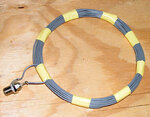Mohammad_Pirzadi
Advanced Member level 4
- Joined
- Nov 15, 2016
- Messages
- 100
- Helped
- 0
- Reputation
- 0
- Reaction score
- 0
- Trophy points
- 16
- Location
- Khorramabad, Iran
- Activity points
- 829
Some of us are getting just a little bit tired of your continual DEMANDS.
yes, I know that you have tired by me. excuse me!
but it's vital for me.
- - - Updated - - -
hi Mr. Brian. excuse me for persistent question. but if you want the fact, I am under excessive pressure by my boss. he gave me an ultimatum to January 1 for realizing this project. I am so tired by my PhD thesis and this project disturbed my life. I earned very useful information by you but help me to finalize this project.That's a great example of lateral thinking! It would certainly allow a small battery powered motor to spin the magnet and have a reasonable life expectancy. I'm thinking the magnet would have to be aligned so maximum N and S fields radiated at 90 degrees to the pipe. I'm no expert in 'power' magnetism but I wonder if the pipe might form a shorted magnetic loop around the field and counter-drive the motor, making it harder to rotate. There is also the issue of the body of the Pig counter-rotating as well but there might be a solution in using two magnets, presumably spaced as far apart as possible but rotating in the opposite directions. Please don't ask me to calculate the resulting field pattern, it would be a nightmare to work out.
Brian.
what is your final&practical approach? (economic design should be cared).
to build an in-pipe transmitter, should we use 22Hz frequency or we can use higher frequencies?
thanks to all who helped me and excuse me for continuous questioning. best regards
Mohammad
Last edited:

